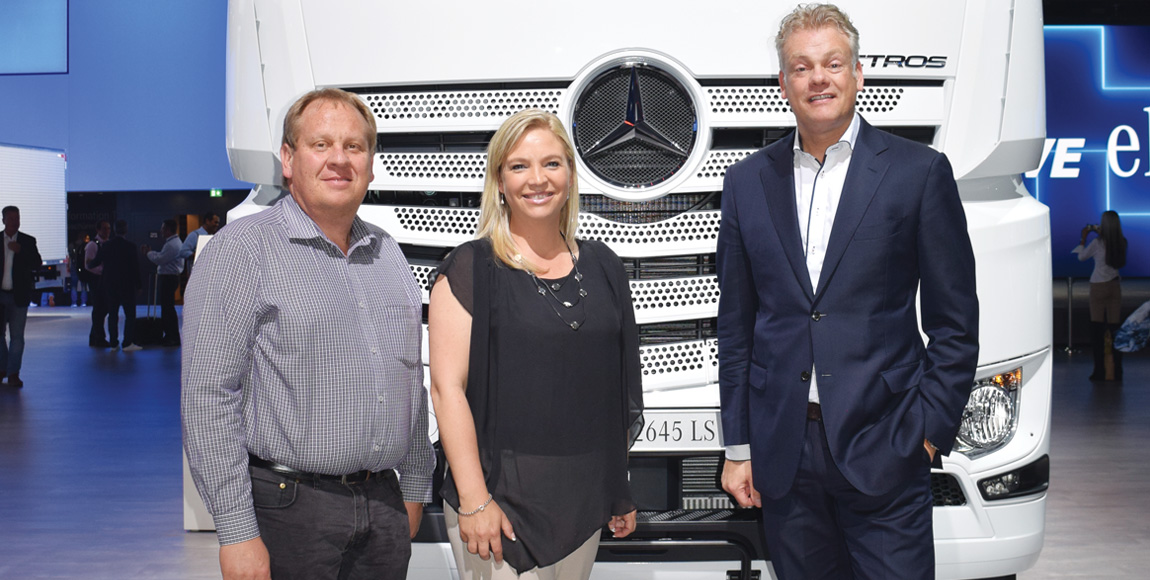Mercedes-Benz flies the SA flag at the IAA!

While the launch of the new Mercedes-Benz Actros and a concept van attracted the attention of international visitors at the IAA, it was the display of a South African Actros and the presence of the South African Mercedes-Benz management team that caught CHARLEEN CLARKE´s eye.
As is always the case at the IAA, Mercedes-Benz stunned visitors with a huge display of world-class vehicles. This year, the new Mercedes-Benz Actros (with its fancy cameras instead of mirrors) and an incredible concept van got the tongues of the international visitors wagging. (Read more about both in our special IAA report, which starts on page 26.)
However, there were two even more important aspects to the Daimler stand this year: the presence of a South African Actros and the South African management team. The local company was very well represented, with Jasper Hafkamp, executive director, Daimler Trucks and Buses; Maretha Gerber, head of Mercedes-Benz Trucks and Christo Kleynhans, marketing manager for Mercedes-Benz Trucks, all attending the fair.
I was fortunate to get an exclusive interview with all three people, and to gain a real understanding of where the local company is heading.
The good news is that Mercedes-Benz South Africa is mimicking the mindset of its German parent company exactly, in that it aims to deliver innovations to customers that will make them both more efficient and profitable.
Hafkamp looked as though his chest would burst with pride when walking around the massive and hugely impressive Daimler stand. “As you can see, this stand is all about innovation. Everyone is talking about electrification and autonomous driving, but, here at the IAA, we are delivering,” he pointed out.
As he noted, the company is well ahead of the pack. “Incredibly, the new Actros is delivering stage-2 autonomous driving. Furthermore, it comes with some incredible features, such as cameras instead of mirrors. These cameras – known as MirrorCams in the Daimler world – are great news for safety and fuel efficiency. Safety is improved, because visibility is outstanding. This is especially important in South Africa, where road safety is a real concern.

“Furthermore, operators can enjoy one-percent fuel savings just by using these cameras instead of conventional mirrors – and, given the ever-escalating price of fuel, this is something that will be welcomed by South African operators. The improved Predictive Powertrain Control (PPC) also allows significant fuel savings, and it relieves the driver’s workload on overland routes,” he pointed out.
Indeed, those two benefits – safety and fuel efficiency – will no doubt have South African transporters beaming, but how long will they have to wait for the incorporation of features such as MirrorCam? After all, the new Actros was launched internationally in 2011 – and it only arrived in South Africa in May this year…
At this stage, we cannot reveal exactly when these features will arrive in South Africa, because there is still much work to be done, as Kleynhans explained. “We will look at all the features of the latest Actros and decide which will add value. We are not going to add options just for the sake of it. Some of the options will require homologation in South Africa, and this will obviously take time, too.
“We will need local testing in our environment to see how the various systems perform in our country, taking our unique road conditions into account. For instance, we need to establish if the autonomy will work in South Africa, where infrastructure is challenging in terms of the road markings. We cannot predict an exact date – because there is still a lot to do,” he explained.
However, according to Gerber, we won´t have to wait nearly as long as we did for the new Actros. “We see real benefit in many of the innovations on the latest Actros. Take Active Brake Assist 5, for instance; it is an amazing safety feature that will save lives. Then there is Active Drive Assist (ADA), which makes semi-automated driving possible…” she pondered.
Operators are expected to welcome these safety features – when they do become available. “South African operators were previously known for putting profitability first … but things are changing. Lots of our customers are now insisting on safety equipment in the trucks.
“One reason is the challenges that we have with drivers. Accordingly, the easier you can make it for the driver to keep the truck on the road, the better. Also, improved safety drives costs down. We all know the high cost of accidents – not only in terms of human lives, but also in terms of the bottom line,” Kleynhans commented.

Of course, the Mercedes-Benz team is mindful of the cost elements. “With our global approach, all these innovations will not only be available in Europe but also in export markets.
“Do we need and want the digital dashboard, the MirrorCam, Active Brake Assist 5, PPC, ADA…? These features are all available to us; we will be able to pick and implement the features that we want. We now need to decide which innovations could be most beneficial in South Africa,” said Hafkamp.
“We also need to hold focus groups with drivers and operators,” added Gerber. “Take the interactive digital dashboard, for instance; it is quite futuristic, but we are living in the age of connectivity. We are in the digital age, but will local transport operators see the value in such a fancy dashboard? That question still needs to be answered. There will be mixed opinions. We will ask the drivers and operators for their opinion – and then introduce it if they want it.”
It is clear that this management team is passionate about meeting (and, if possible, exceeding) customers´ expectations. “We operate in a demanding environment. This means that we always have to change, re-evaluate and improve. This is a constant and ongoing process.
“One of the changes we are making is the introduction of Mercedes-Benz Uptime next year. This is a program with a clear objective: we want to continuously minimise unscheduled vehicle downtime and to make it predictable – thereby further increasing vehicle availability for customers.
“Thanks to Uptime, we will be able to foresee faults on vehicles, and we will then be able to inform a client that he needs to bring in his truck for repairs. This will prevent costly damage from taking place,” Gerber revealed.
Thanks to Mercedes-Benz Uptime, the vehicle, coupled trailer, Mercedes-Benz dealer and transport operator are in constant communication. The truck´s on-board systems generate several gigabytes of data per truck per day, which is used for a variety of vehicle diagnostic functions. The operator is told that the truck has a fault and the dealership knows exactly what the problem is – long before the truck even arrives.
Mercedes-Benz Uptime was introduced in Europe last year, and it has been massively successful there. “With the majority of Mercedes-Benz Uptime vehicles, unscheduled workshop visits have already been reduced by over half thanks to early fault detection,” Hafkamp reveals.
Coupled with the introduction of Uptime is an ongoing emphasis on total cost of ownership (TCO). “We are striving to educate operators. This is our responsibility. They need to understand the significance of TCO – and not buy a truck just because it happens to have a low purchase price,” stressed Kleynhans.
This is especially important with newcomers to the industry. “We are seeing more and more emerging operators enter the industry, often initially via pre-owned trucks. They need to understand TCO, uptime, fuel efficiency, service contracts and service support…
“Our sales force is crucial in this situation. They need to advise customers when it comes to buying the right truck for a particular application. In a situation like this, the sales person is actually a fully integrated business partner for these clients,” explained Gerber.
The company is also stressing the importance of driver training. “Yes, trucks are becoming more autonomous, but a well-trained driver can still save 10 to 15 percent on fuel. This can mean a cost saving of R400 000 to R500 000 during the life of a truck. It is very important for our customers to invest in training. Our FleetBoard system also offers terrific driver support – because it provides feedback,” Hafkamp stressed.

So, going into the future, it will be a case of marrying exceptional technology to a world-class service offering. “As a brand, we are the leader in innovation and in the transport industry. The South African vehicle on our stand proves that we are not that far behind. Yes, Europe is ahead of us, but we are constantly introducing new technology,” pointed out Kleynhans.
Hafkamp agreed: “We are not bringing innovation for the sake of it. It is not an objective on its own. We are fighting for the benefit of our customers. We want road efficiency, the lowest possible cost of ownership, improved safety and maximised uptime. All our innovations contribute to this, so we are offering tangible benefits to our customers.”
Accordingly, the vehicle will be only a part of the total offering. “We are focusing on the full package. Yes, the vehicle, with its fuel-saving features and extended service intervals, is obviously important, but it is about more than that.
“It is about the full end-to-end solution that we offer, from the service we deliver and the footprint of the dealer network, to the tracking functionality through our FleetBoard system and all of the added features that we bring to the deal,” insisted Gerber.
Most of all, Mercedes-Benz will continue to be the leader in innovation. “An example of our approach is this stand. Everyone talks about innovation and fuel efficiency. Now we are delivering both. That is what makes this show and this stand so unique: no one expected this from us so soon,” she concluded. One thing is certain: the company is full of surprises that are sure to delight customers – both all over the globe and here in South Africa…
Published by
Focus on Transport
focusmagsa




